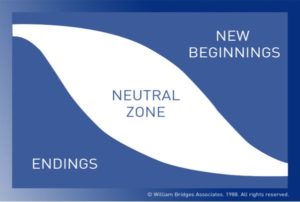Navigating Life’s Transitions
As we approach the end of our GFU journey, it seemed fitting that our last assigned book related to the topic of transition. Many of the books about change I have read focus on the external aspects, namely, the circumstances of transitioning. William Bridges’ self-management book Transitions, in this second edition, includes his wife, Susan, as an author. Together, they focus on the person’s journey going through some significant life alteration. The authors vitally differentiate between change and transition. Change is external, while transition is internal. A central premise of the book relates to the difference between the circumstances around a person versus the personal, internal experience brought on by a transition. The Bridges draws a sharp distinction between change, which they say is situational, and transition, a personal psychological process that requires an “inner re-orientation and self-redefinition that you have to go through in order to incorporate any of these changes into your life.”[1] This distinction and implication came as a new insight for me.
The book is arranged into two main sections. The first deals with the need for change as it is an ever-present reality. The second section details the transition process itself. Bridges’ model identifies three stages of transitions that serve as the book’s second half. A visual representation of Bridges’ model helped my understanding of the relationship between the three stages:
The first phase he calls the Ending. This phase includes loss of some kind and a form of letting go necessary due to the loss. Preparation and response are essential dynamics of navigating the pain that often accompanies some form of an ending. The loss may be relational, professional, or personal, such as a loss of one’s health. Regardless of the type of loss, an ending begins, not completes, a transition.
The author lists five “dis” dynamics that accompany the Ending. Disengagement, dismantling, disidentification, disenchantment, and disorientation detail the high volume of inner-world struggle embedded in transitions. As Bridges stresses the internal emphasis, he states, “Looking back at the five words starting with ‘dis,’ note that only ‘disengagement’ refers exclusively to external things.”[3] While never denying external realities, Bridges drives the reader to look within and toward honesty about the challenges of change. He ends the section on Ending with this profound point: “We have it backward. Endings are the first, not the last, act of the play.”[4]
Bridges’ second phase of transition is the Neutral Zone. The in-between space involves coming to terms with the ending but does not yet include the future next chapter of the future. “The neutral zone is a time when the real business of transition takes place.”[5] People respond differently to change that affects them personally. This stage may include resistance or embracing the transition. Those who respond well to transition can move quickly to the third and final stage while those who struggle may stay stuck in the Ending or the Neutral Zone. It sounds counterintuitive to view this stage as life-giving, but the Bridges believe that to be true. Susan Bridges states, “The essence of life takes place in the neutral zone phase of transition. It is in that interim spaciousness that all possibilities, creativity, and innovative ideas can come to life and flourish.”[6]
The third transition phase is the New Beginning. This third stage is an opportunity to move and thrive in a transformed future. Energy often accompanies the acceptance of a new future. People tend to be receptive to learning and commit or recommit to their new place and those found there. Bridges calls a person’s establishment in the New Beginning a “return.” “Psychologically, the process of return brings us back to ourselves and involves a reintegration of our new identity with elements of our old one. This connection is necessary if we are going to be grounded and not up in the clouds.”[7] A new chapter of life brings new energy and direction.
My journey with transition has taken a recent unexpected turn. For some time, I anticipated a change from my role as Lead Pastor into another ministry context. Whether that transition led to missions or chaplaincy, I began to emotionally prepare myself and the staff for an intentional departure process. However, recent growth has demanded a major expansion of our church facility. To leave prior to or during an expansion is not a wise move, nor fair to the next Lead Pastor. In recent months, I have determined to see the expansion project through to completion, and the potential next Lead Pastor, who is currently on staff, has agreed to a four to six-year delay.
Honestly, I am in a strange place emotionally. When you prepare to begin the process of leaving and then recommit to staying, it takes an emotional toll. Transitions helped me identify specific struggles and reactions in recent times. Engaging the paradigm above, I feel like I started the Ending, even stared into the Neutral Zone, but have now backed away. I have known for the first time the sequence that “loss is the first act of a process, not the last act of a situation.”[8] Then again, is any journey a straight line in one direction? I think not.
[1] William and Susan Bridges, Transitions: Making Sense of Life’s Changes (New York: Lifelong Books, 22019), xiii.
[2] “Bridges Transition Model,” William Bridges Associates, accessed April 11, 2023, https://wmbridges.com/about/what-is-transition/.
[3] Transitions, 132.
[4] Ibid., 135.
[5] Ibid., 158.
[6] Susan Bridges, “Bridges Transition Model,” William Bridges Associates, accessed April 12, 2023, https://wmbridges.com/about/what-is-transition/.
[7] Transitions, 179.
[8] Ibid., 194.

Leave a Reply
You must be logged in to post a comment.